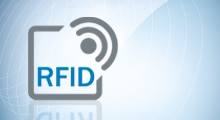Pieces of plastic in chocolate bars, bacterial contamination of cream cheese, falsely declared ingredients in pasta-based ready meals – a food product may be recalled for any number of reasons. As well as damaging the manufacturer’s reputation, these situations often come at tremendous expense, with costs rising as the whereabouts of the end products become less clear. Not to mention that time is of the essence when it comes to product recalls. With identification systems and integration technology, foodstuffs can be identified at any point as they make their way from the producer to the end customer, providing the option of tracing them in real time and at item level with the click of a mouse should a critical situation arise.
Bar codes, 2D codes, or electronic transponders are used to identify objects depending on whether they are individual items, primary and secondary packaging, pallets, trucks, or swap bodies. When it comes to deciding on which technology to use, it is important to take financial factors into account as well as considering the objects and processes involved. For example, a bar code can be printed onto an egg, while the cartons holding six or ten eggs can be labeled up with 2D codes and additional plain text, such as the best-before date. A transponder, on the other hand, can be added to shipping cartons, pallets, and other aggregated containers. It is often the case that several of these different forms of labeling will be in place within a single company along the supply chain. This is where the 4Dpro integration platform comes in, as it can be used not only to manage the range of identification technologies that are physically different from one another, but also to enter data into databases – which will ideally be interconnected – via standard software.

Food contamination: Eliminating residual risks using track and trace
Making every effort to ensure process reliability, hygiene, and quality is sure to minimize the risk of contamination during industrial production, packaging, and distribution processes within the food industry, but it can never rule it out entirely. On this basis, Regulation EC 178/2002 requires manufacturers within the food industry to establish systems that enable traceability of foodstuffs across all stages of production, processing, and distribution. In addition, manufacturers have been given responsibility for promptly recalling unsafe products in order to avoid potential health risks.
Product recalls have a detrimental effect on a company’s reputation and finances as well as the brand promise for the product in question. They are a surefire way to lose consumers’ trust and constitute a major challenge for the entire supply chain, with repercussions for producers, processors, packagers, distributors, freight forwarders, supermarkets, and retailers. All parties have to work closely together if a product recall is to run smoothly.
To allow them to assess the causes of a contamination, companies must be able to trace back the trajectory of their products from the producer, through the processing stages, to retailers. This means that products and the containers they come in need to be labeled consistently and identified at every stage of the process that may prove relevant in the event of a recall, with data being entered automatically into interconnected databases. This is the only way to minimize residual health risks for consumers, with a system in place that allows the affected products to be tracked down and removed from circulation as quickly as possible.
Taking proactive measures to limit damage
By fulfilling the legal obligation to trace foodstuffs using the appropriate track-and-trace technology, companies can minimize the negative impact on their image and brand, and limit the financial damage caused by the loss of sales and costs involved in recalling a product. The key point to remember here is that the more information available to the manufacturer about the exact serial numbers, batches, production facilities, or best-before dates affected by a product recall, the easier it will be to retrieve these items – or in extreme cases a single item – in a targeted and proactive way. This is all possible thanks to modern track-and-trace solutions featuring state-of-the-art technology, which can be used to narrow products down to those affected and then pinpoint their location within the supply chain. All of the information needed during a product recall can also be retrieved from interconnected databases in real time with more or less the click of a mouse, making reaction times incredibly quick.
Identification systems recording information needed during a product recall
Information recorded by automated identification systems is fed into the databases. Bar code readers in the various CLV product families from SICK can be used in a broad range of applications within track-and-trace set-ups. They can read compact codes on labels and item packaging as well as bar codes with large module widths, such as those used to label shipping cartons and pallets. Offering a variety of scanning ranges, auto focus, ambient light immunity, and smart code reconstruction technology, these readers make for versatile and reliable solutions that can be used to accurately identify bar codes even when faced with varying container sizes, working distances, and lighting conditions, or labels and prints that have been partially destroyed. The CLV bar code scanners are also available in a hygienic design if required for applications involving the identification of foodstuffs and beverages within humid and wet areas in packaging and bottling plants.
2D codes are a very popular type of labeling for food and drug packaging. They are useful when space is very restricted given that they can hold a lot more information than bar codes. Plus, extremely reliable integrated correction processes eliminate errors when codes are read. The image-based code readers in the Lector620 OCR product family can be relied upon to record bar codes, 2D codes, and plain text information on food packaging, including best-before dates and batch numbers. Another example of their functionality is the option to identify Data Matrix codes on carton blanks in the feed magazines for packaging machines, in order to check that food packaging does actually contain the product it should contain according to the text and images printed onto it. If foodstuffs packaged in folding boxes are put into secondary packaging, the code readers within the Lector650 product family can be used to identify all of the items combined within the container, thereby allowing for full traceability, even for aggregation units of this kind.

Reliable identification using RFID technology
With the exception of containers that are very large to start with and premium consumer items, product labeling using RFID technology is opening up an increasingly wide range of applications, primarily as a result of costs dropping and processor technologies becoming more efficient. In this case, an electronic data card, known as a transponder, is attached to an item, a pallet of goods, or a container of raw material. During the logistics process, reading systems such as the RFU620 UHF read/write device read the transponder, which is then written to – that is, updated – based on the process. This reading and writing process also happens to be one of the main advantages of RFID over bar codes and 2D codes. Plus, as no visual contact with the transponders is required during the identification process and given that it is possible for reading and writing to be performed simultaneously for several transponders in a group, all items labeled with RFIDs in shipping cartons and then all cartons labeled with RFIDs on a pallet, for instance, can be recorded in one go. Attaching an RFID label to the pallet would then allow to be traced consistently and efficiently.
Industrial image processing moving towards the future
Vision sensors which record 1D bar codes and 2D codes provide additional food for thought when it comes to Industry 4.0. The combination of image and bar code recognition – reading a code while simultaneously checking against a stored image – ensures that the right product goes into the right package. This rules out the possibility of a product making it onto the shelf with information, such as the best-before date or details required by labeling standards, appearing incorrectly on the packaging. Data is ultimately analyzed via the SICK AppSpace eco-system, which is based on the approach of integrating in-house ideas and implementing customer-specific requirements efficiently in the form of customized sensor apps.
Turning a problematic product recall into a positive?
Even the possibilities now afforded by innovative identification and integration technology cannot prevent product recalls from happening, but they can seriously limit their negative repercussions in terms of reputation, brand image, sales, and costs. Some companies may even seize the concept of product safety through proactive recall management – and turn what was once a challenging problem into a way to give themselves a competitive edge.



